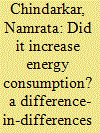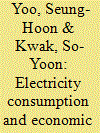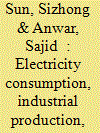|
|
|
Sort Order |
|
|
|
Items / Page
|
|
|
|
|
|
|
| Srl | Item |
| 1 |
ID:
181465


|
|
|
|
|
| Summary/Abstract |
To realize the “Green” economic development, China has to transform the extensive mode of growth with the power factor inputs being the main driving force gradually into an intensive one. It's important to quantitatively analyze the relationship between the power factor input and economic growth and understand the core factors that affect the coordinated development between them. We introduce the concept of “power dependence,” based on the counter-factual method, use “growth drag” to reflect the dependence of China's economic growth on the power factor input. Based on the measurement of national power dependence, the auto-regressive distributed lag (ARDL) model is used to develop an empirical analysis of its influencing factors, and the robustness of the findings is tested by using the inter-provincial panel data. The findings show that China's economic growth has depended on the power factor input to some extent. According to the results, we propose suggestions from the aspects of promoting economic development, improving the pricing mechanism, adjusting the power generation structure, reasonably regulating the introduction of the foreign direct investment and research and development investment, and optimizing industrial structure to find an effective means to reduce the dependence of China's economic growth on the power factor input.
|
|
|
|
|
|
|
|
|
|
|
|
|
|
|
|
| 2 |
ID:
149943


|
|
|
|
|
| Summary/Abstract |
The Covenant of Mayors (CM) is an initiative by which towns, cities and regions voluntarily commit to reduce their CO2 emissions beyond the European Union climate targets, through policies promoting energy saving and renewable energy. The aim of this paper is to analyze whether joining the CM is reducing municipalities' electricity consumption, and therefore their emissions. For this purpose, the evolution of total, household and public administration electricity consumption from 2001 to 2012 is analyzed by using panel data econometric techniques. This analysis is made for municipalities in Andalusia, the region of Spain with more signatories. Obtained results show that the CM is having a positive effect on the electricity consumption reductions, since the municipalities have greater rates of reduction of electricity consumption after signing the CM. Therefore, it may be considered appropriate to promote policies which incentivize the municipalities to join the CM and develop their action plans, as this can reduce their electricity consumption.
|
|
|
|
|
|
|
|
|
|
|
|
|
|
|
|
| 3 |
ID:
176748


|
|
|
|
|
| Summary/Abstract |
Daylight Saving Time (DST) policies have been in use since early in the 20th century. However, their energy saving effect is under review. The generalization of LED lighting has reduced the impact of lighting energy on the total energy consumption and, therefore, the effect of DST has been reduced. Nevertheless, in order to design an effective new policy in this aspect, it is necessary to understand how total electricity consumption would be affected by it but also how the load daily profile would change. This paper proposes an hourly load model that quantifies the effect of daylight on electricity consumption and simulates the effect of different DST policies. The model is applied to the inland Spanish electricity system and the three scenarios more likely to be implemented if current DST policy is changed: year round winter time (UTC+1), year round summer time (UTC+2) and keep DST but change clock 1 h back (GMT). The results show how changes in sunrise and sunset times affect daily load profiles. They provide overall, monthly and hourly energy savings for each scenario that are necessary for a well-informed DST policy design and implementation.
|
|
|
|
|
|
|
|
|
|
|
|
|
|
|
|
| 4 |
ID:
092744


|
|
|
|
|
| Publication |
2009.
|
| Summary/Abstract |
Introduced at the end of the 1970s to study the impacts of structural changes on electricity consumption by industry, index decomposition analysis techniques have been extended to various other areas to help in the formulation of energy policies, notably in developed countries. However, few authors have applied these techniques to study the evolution of energy consumption in developing countries. In Brazil, the few available studies have focused only on the industrial sector. In this article, we apply the decomposition technique called the logarithmic mean Divisia index (LMDI) to electricity consumption of the Brazilian residential sector, to explain its evolution in terms of the activity, structure and intensity affects, over the period from 1980 to 2007. The technique is sufficiently robust and flexible to perform this analysis, by disaggregating residential consumers by consumption classes and regions of the country. Among the main results is measurement of the impact of government programs for income transfer and universal service on variations in residential consumption, typical of developing countries.
|
|
|
|
|
|
|
|
|
|
|
|
|
|
|
|
| 5 |
ID:
116746


|
|
|
|
|
| Publication |
2012.
|
| Summary/Abstract |
The objective of the study is to re-investigate the multivariate electricity consumption function for Pakistan, particularly, economic growth, foreign direct investment and population growth over a 36-year time period, i.e., between 1975 and 2010. The study employed the bounds-testing procedure for cointegration which examines the short-run and long-run estimates. Dynamic short-run causality test is applied to determine the causality direction between electricity consumption and its determinants, by using Wald-F statistics. The results reveal that determinants of electricity consumption function are cointegrated and influx of foreign direct investment, income and population growth is positively related to electricity consumption in Pakistan. However, the intensity of these determinants is different on electricity consumption. If there is 1% increase in income, foreign direct investment and population growth; electricity consumption increases by 0.973%; 0.056% and 1.605%, respectively. This infers that income, foreign direct investment and population growth induce an increase in electricity consumption in Pakistan. Dynamic short-run causality test indicates that there has been unidirectional causality which is running from population growth to electricity consumption in Pakistan.
|
|
|
|
|
|
|
|
|
|
|
|
|
|
|
|
| 6 |
ID:
176732


|
|
|
|
|
| Summary/Abstract |
Lesotho has a poverty rate above 50%, this renders a bulk of households connected to the grid unable to purchase enough energy to cover the essential basic needs at the current tariffs. This is supported by the declining average household consumption reported by Lesotho Electricity Company (LEC) despite an increasing customer base. Even more crucial, for low income countries, tariff levels should balance social stability, affordability, fairness, energy efficiency as well as cost recovery especially because the poor make up the majority of the population. Based on the poverty line, a lifeline tariff of 0.5 to 0.6 Maloti(M)/kWh (2017 tariffs) for a threshold of up to 30 kWh/month is proposed which is 35%–42% lower than the current domestic tariff of 1.424 M/kWh. The standard domestic tariff will need to increase to 1.856 M/kWh to allow for cross-subsidisation and hence maintain the financial standing of the utility company. The threshold capacity is based on the observation that in 2016, around 30% of grid connected households consumed less than 30 kWh/month which is enough electricity to cover the basic needs of an average household. Hence, an increasing block tariff (IBT) approach is proposed such that the first 30 kWh/month are set at a lifeline tariff and any excess is charged at a standard rate which is set such that it cross-subsidises the lifeline tariff.
|
|
|
|
|
|
|
|
|
|
|
|
|
|
|
|
| 7 |
ID:
192806


|
|
|
|
|
| Summary/Abstract |
Electricity access is an important issue and building capacity for it requires drawing relevant lessons from past policies. In this study, we evaluate the effect of the Jyotigram Yojana, or the lighted village scheme, a supply-side policy intervention during 2003–08 to increase rural electricity access in Gujarat, India. We hypothesize that policy implementation is associated with increased electricity consumption. To test this hypothesis, we exploit variation in the timing of policy implementation at the village level, and use a generalized difference-in-differences strategy for identification. Further, we use night-time luminosity measured through remote sensing as a proxy for electricity consumption, and control for weather, village fixed effect, year fixed effect, and village or administrative block specific time trend. We find that while the overall effect of the policy on night-time luminosity was not statistically significant, the effects were likely heterogeneous, with the night-time luminosity increasing in some districts after policy implementation and decreasing in others. We conclude that the policy might have had a re-distributive effect on electricity access or consumption and recommend adopting a more holistic approach – incorporating both supply-side and demand-side measures – to increase electricity access.
|
|
|
|
|
|
|
|
|
|
|
|
|
|
|
|
| 8 |
ID:
183609


|
|
|
|
|
| Summary/Abstract |
One of the pertinent concerns that Pakistan is facing nowadays is the ever-increasing demand for energy. The government of Pakistan has been reducing subsidies on commercial fuels due to mounting fiscal burden and fluctuating oil prices. This study analyzes the distributional impact of phasing out residential electricity subsidies on household welfare. The direct, as well as indirect effects of phasing out electricity subsidies, have been estimated. The results suggest that a rise in the prices of electricity causes a significant decrease in the real expenditure of households in all expenditure quintiles. However, the decline is greater for the relatively affluent households than the relatively poor households implying that the benefit of introducing electricity subsidies would be regressive. The results also show that the indirect effect of subsidy removal is far greater as compared to the direct effect. Electricity prices rise due to subsidy removal would increase the price of other goods, which will ultimately result in cost-driven inflation with some lags. Hence, the government must focus on the indirect subsidy reform effects accompanied by a more cost-effective policy to protect the poor.
|
|
|
|
|
|
|
|
|
|
|
|
|
|
|
|
| 9 |
ID:
171372


|
|
|
|
|
| Summary/Abstract |
The European Union has recently decided to stop the policy of biannual clock changes in 2021. One reason is that the original rationale for the policy, energy savings, is not supported by a large portion of recent empirical studies. Whether the new permanent time will be standard time or the former daylight saving time has not been decided. Evidence on energy savings from daylight saving time is country-specific, and each country may choose its own time. We examine the effects of the policy in a country for which no studies on daylight saving exist, Slovakia. Using hourly data from the 2010–2017 period, we apply a difference-in-differences approach and estimate energy savings to equal 1% of annual electricity consumption. Alternatively, extrapolating the effect from the results of a previous meta-analysis on different countries, for Slovakia we obtain a smaller estimate, unlikely to exceed 0.5%. Moreover, our findings suggest that daylight saving time smooths the electricity demand curve.
|
|
|
|
|
|
|
|
|
|
|
|
|
|
|
|
| 10 |
ID:
125519


|
|
|
|
|
| Publication |
2013.
|
| Summary/Abstract |
In this paper, we use a panel of the 48 contiguous US states over the period 1970-2009 to examine the dynamics of electricity demand in addressing the four hypotheses set forth in the literature: growth, conservation, neutrality, and feedback. In doing so we provide both short-run and long-run elasticity estimates for electricity demand. Recent developments in nonstationary panel estimation techniques allow for heterogeneity in the coefficients while examining the direction of causality among electricity consumption, electricity prices, and income growth. In addition to the full sample, we also disaggregate the sample into three sectors: commercial, industrial, and residential. The short-run results provide evidence in favor of the growth hypothesis for the aggregate sample, as well as for the industrial sector. For the residential and commercial sectors, the conservation hypothesis is supported. Long-run results favor the conservation hypothesis. To ascertain differences in electricity demand relating to electricity intensity we also examine states based on their efficiency in electricity consumption. Overall, the results yield in favor of the growth hypothesis for low intensity states and conservation hypothesis for high intensity states.
|
|
|
|
|
|
|
|
|
|
|
|
|
|
|
|
| 11 |
ID:
096745


|
|
|
|
|
| Publication |
2010.
|
| Summary/Abstract |
This paper applies recent panel methodology to investigate the long-run and causal relationship between electricity consumption and real GDP for a set of 12 European countries using annual data for the period 1970-2007. The sample countries have moved faster than other neighboring countries towards the creation of a single electricity market over the past 30 years. Energy prices are also included in the study due to their important role in affecting the above variables, thus avoiding the problem of omitted variable bias. Tests for panel unit roots, cointegration in heterogeneous panels and panel causality are employed in a trivariate VECM estimated by system GMM. The results show evidence of a long-run equilibrium relationship between the three series and a negative short-run and strong causality from electricity consumption to GDP. As expected, there is bidirectional causality between energy prices and GDP and weaker evidence between electricity consumption and energy prices. These results support the policies implemented towards the creation of a common European electricity market.
|
|
|
|
|
|
|
|
|
|
|
|
|
|
|
|
| 12 |
ID:
097600


|
|
|
|
|
| Publication |
2010.
|
| Summary/Abstract |
This paper applies recent panel methodology to investigate the long-run and causal relationship between electricity consumption and real GDP for a set of 12 European countries using annual data for the period 1970-2007. The sample countries have moved faster than other neighboring countries towards the creation of a single electricity market over the past 30 years. Energy prices are also included in the study due to their important role in affecting the above variables, thus avoiding the problem of omitted variable bias. Tests for panel unit roots, cointegration in heterogeneous panels and panel causality are employed in a trivariate VECM estimated by system GMM. The results show evidence of a long-run equilibrium relationship between the three series and a negative short-run and strong causality from electricity consumption to GDP. As expected, there is bidirectional causality between energy prices and GDP and weaker evidence between electricity consumption and energy prices. These results support the policies implemented towards the creation of a common European electricity market.
|
|
|
|
|
|
|
|
|
|
|
|
|
|
|
|
| 13 |
ID:
186427


|
|
|
|
|
| Summary/Abstract |
This paper uses household survey data from Australia to investigate whether renters face larger energy bills than otherwise similar households. We find that a negative unconditional effect of renting on residential electricity expenditure becomes positive when controlling for log net wealth, with renters on average spending about 8% more than otherwise similar households. This is a larger effect than in most prior studies. The effect operates via higher usage quantities rather than higher average prices, and a similar effect is found for overall residential energy expenditure including natural gas. Central to the story is that renters tend to have lower net wealth, and net wealth is associated with higher energy use due to reasons including additional appliance ownership. This makes net wealth an important control. The findings cast light on the potential for more ambitious policy responses to reduce energy-related disadvantages faced by renters in Australia. There is also scope for further research into whether similarly large effects are evident in other countries.
|
|
|
|
|
|
|
|
|
|
|
|
|
|
|
|
| 14 |
ID:
176882


|
|
|
|
|
| Summary/Abstract |
One explanation that can be associated with the inadequate focus on demand-side management of household electricity consumption is the poor knowledge on consumption inefficiency. This study estimates the efficiency of Ghanaian households' electricity consumption and factors influencing inefficiency using the energy demand frontier model and data from the seventh round of the Ghana Living Standards Survey. The results indicate that income is inelastic to electricity demand while price elasticity to demand is inversely related. Appliance ownership, number of rooms, location and ecological zones significantly affected electricity demand. The mean efficiency score is 63.0% for the entire sample and, 69.9% and 66.3% for rural and urban households respectively, suggesting the existence of an immense potential for implementation of energy efficiency measures. Factors that negatively influence efficiency included education, ageing and power outages. Households living in bungalows and apartments are less efficient compared to those in compound houses possibly because of self-monitoring behaviour. Compared to very poor households, poor and non-poor households are less efficient in electricity consumption while public sector employees are less energy efficient compared to the unemployed. Policy choices should focus on standardization of appliances, education on energy efficiency and development of the rural appliance markets through incentives.
|
|
|
|
|
|
|
|
|
|
|
|
|
|
|
|
| 15 |
ID:
119803


|
|
|
|
|
| Publication |
2013.
|
| Summary/Abstract |
This article addresses the issue of electricity consumption, petroleum price and economic growth in Algeria. The primary objective is to investigate and analyze the causal relationship between electricity consumption (EC), Brent oil price (BOP) and economic growth (GDP) for Algeria over the period of 1971-2010. To examine short-run, long-run and joint causality relationships we used a multivariate cointegration approach based on the recent advances in time series econometrics (e.g., Zivot-Andrews test; Gregory-Hansen cointegration test; Vector Error Correction Models (VECM)). The empirical results show that there is evidence of short-run and a strong long-run bi-directional causal relationship between EC and real GDP in Algeria. Findings indicate also the absence of causal relationship between BOP and EC. Our empirical findings support the idea that there a link between electricity consumption and economic growth and disproves the neo-classical assumption referred to as the "neutrality hypothesis".
|
|
|
|
|
|
|
|
|
|
|
|
|
|
|
|
| 16 |
ID:
093482


|
|
|
|
|
| Publication |
2010.
|
| Summary/Abstract |
This paper attempts to investigate the causal relationship between electricity consumption and economic growth among seven South American countries, namely Argentina, Brazil, Chile, Columbia, Ecuador, Peru, and Venezuela using widely accepted time-series techniques for the period 1975-2006. The results indicate that the causal nexus between electricity consumption and economic growth varies across countries. There is a unidirectional, short-run causality from electricity consumption to real GDP for Argentina, Brazil, Chile, Columbia, and Ecuador. This means that an increase in electricity consumption directly affects economic growth in those countries. In Venezuela, there is a bidirectional causality between electricity consumption and economic growth. This implies that an increase in electricity consumption directly affects economic growth and that economic growth also stimulates further electricity consumption in that country. However, no causal relationships exist in Peru. The documented evidence from seven South American countries can provide useful information for each government with regard to energy and growth policy.
|
|
|
|
|
|
|
|
|
|
|
|
|
|
|
|
| 17 |
ID:
149847


|
|
|
|
|
| Summary/Abstract |
Applying recent advances in panel data analysis, we investigate the relationship between electricity consumption and economic growth in the GCC countries using annual data from 1975 to 2012. Within a framework which takes into consideration dynamics, heterogeneity and cross-sectional dependence in the panel, we show that the results obtained from using the PMGE, demeaned PMG, AMG, MGE and DFE models indicate a long-run equilibrium relationship between electricity consumption and economic growth. In order to determine the appropriate model and decide the preferred estimator, the Hausman test was performed. The PMGE model emerged as the most efficient of the three estimators. Also, the results obtained revealed a bi-directional causality between economic growth and electricity consumption in these countries, which supports the feedback hypothesis. As a result, this implies that if these countries adopt or implement any energy or electricity conservation policies, this may have a negative impact on its economic growth.
|
|
|
|
|
|
|
|
|
|
|
|
|
|
|
|
| 18 |
ID:
125782


|
|
|
|
|
| Publication |
2013.
|
| Summary/Abstract |
This paper attempts to cast light into the relationship between electricity consumption and economic growth in Greece in a multivariate framework. For this purpose we used cointegration techniques and the vector error correction model in order to capture short-run and long-run dynamics over the sample period 1970-2011. The empirical results reveal that in the long-run electricity demand appears to be price inelastic and income elastic, while in the short-run the relevant elasticities are below unity. We also argue that the causal relationship between electricity consumption and economic growth in Greece is bi-directional. Our results strengthen the notion that Greece is an energy dependent country and well directed energy conservation policies could even boost economic growth. Furthermore, the implementation of renewable energy sources should provide significant benefits ensuring sufficient security of supply in the Greek energy system. This evidence can provide a new basis for discussion on the appropriate design and implementation of environmental and energy policies for Greece and other medium sized economies with similar characteristics.
|
|
|
|
|
|
|
|
|
|
|
|
|
|
|
|
| 19 |
ID:
109644


|
|
|
|
|
| Publication |
2011.
|
| Summary/Abstract |
In this paper, an attempt is being made to examine the causal relationship between per capita electricity consumption and per capita GDP of Bangladesh using the vector error correction specified Granger causality test to search their short-run, long-run and joint causal relationships for the period of 1971-2008. Empirical findings reveal that there is a short-run unidirectional causal flow running from per capita electricity consumption to per capita GDP without feedback. The presence of a positive short-run causality explains that an increase in electricity consumption directly affects economic activity in Bangladesh. Likewise, results from joint causality exhibit the same as in short-run. By contrast, long-run results show a bi-directional causality running from electricity consumption to economic growth with feedback. These findings can provide essential policy insights to design immediate and long-term growth prospect for Bangladesh keeping in mind its present planned growth strategy and dismal power and energy sector.
|
|
|
|
|
|
|
|
|
|
|
|
|
|
|
|
| 20 |
ID:
137704


|
|
|
|
|
| Summary/Abstract |
Within the context of a tri-variate vector autoregressive framework that includes entrepreneurship, this paper examines the link between electricity consumption and industrial production in Singapore's manufacturing sector. Unlike the existing studies, this paper focuses on one sector of the economy and utilises a unique monthly dataset. Empirical analysis based on Johansen's cointegration approach shows that the three variables are cointegrated – i.e., a stable long-run relationship exists among electricity consumption, output and entrepreneurship in Singapore's manufacturing sector. Empirical analysis based on data from January 1983 to February 2014 reveals that electricity consumption adjusts very slowly to shocks to industrial production and entrepreneurship. Furthermore, entrepreneurship Granger causes electricity consumption, which causes industrial production. As electricity consumption causes industrial output, the growth hypothesis concerning energy consumption and economic growth holds in Singapore's manufacturing sector and policies that restrict electricity production, without electricity imports, are likely to lead to a decline in the manufacturing output.
|
|
|
|
|
|
|
|
|
|
|
|
|
|
|
|
|
|
|
|
|